イケメンに眼福でした笑。(愛知県名古屋市千種区姫池通 骨董買取 古美術風光舎名古屋店)
2022.07.16
皆さまこんにちは、スタッフYでございます。
このところの線状降水帯による豪雨により大変心配な地区もございます。最新の情報などに留意し、お気をつけてお過ごしくださいませ。
さてさて本日は、先日の八ヶ岳の平山郁夫シルクロード美術館の続編であります。
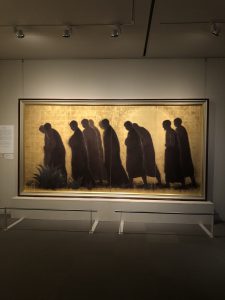
こちらの美術館には日本画家平山郁夫氏の代表作「求法高僧東帰図」(1964)や、大シルクロード・シリーズ(2005)などが展示されているほか、彼が大変影響を受け約40年収集してきたシルクロードの古美術などを収蔵し、順次展示しております。今期は、仏像が初めて作られたガンダーラ地方(パキスタン北部)の美しい仏像たちと、シルクロードを経て、インドから中国、東南アジア、そして日本へと伝えられた仏像たちが展示されておりました。
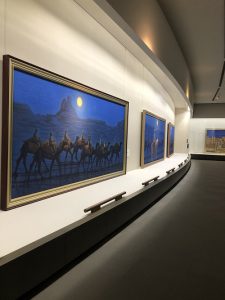
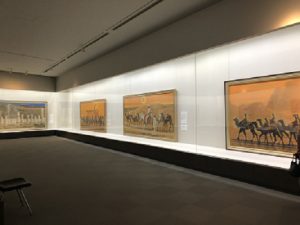
それぞれの地方の仏像を拝見いたしますと、まず気づきますのが、ガンダーラ地方の仏像たちの仏顔が、正真正銘イケメンであること。御髪も豊かに波打ち、鼻筋などシュッとしてまして、伏し目がちにアルカイックスマイルをたたえており、どちらかと申しますと人物に近い仏像ですが、どことなくギリシャ彫刻の影響を受けている様子もうかがえますね。
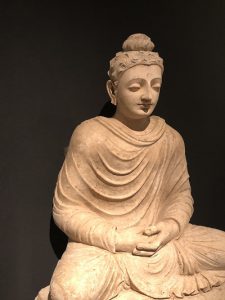
そもそもブッダの死後はブッタの姿を表現することは禁じられていたのですが、1世紀末になると、現在のパキスタン北西部ペシャーワル周辺のガンダーラ地方では仏像・菩薩像が造られるようになります。
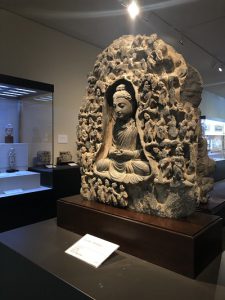
紀元前3世紀半ばに古代ギリシャ人がバクトリア王国をたてて以来、この地には古代ギリシャ(ヘレニズム文化)が栄え、この地は東西からインド人、ペルシャ人、ギリシャ人といった多くの民族による文化の交流が行われてたからでしょうか、仏像はインド文化を元に古代ギリシャ(ヘレニズム文化)の影響を受けています。
お顔だけでなく、波状の頭髪は束ねられており、体格もよくギリシャ風のドレープのある衣服を纏っていることが多いところをみますと、この地方がいかに様々な様式が混ざり合った地区であったことがうかがえしれますし、それを上手に融合しされていたのでしょうか、完全にとまではいかないくらいのその取り入れ方が絶妙であります。それにしても、融合とはこんなにも美しいものを生み出すのですね。
仏像はシルクロードを経て様々な表情に変化していますが、例えばこちらのインドの仏陀像はガンダーラ地方と比べますと、お顔ももう体つきも少しふっくらしておりますし、肉好きよくしたからでしょうかお顔がさらにリアル。
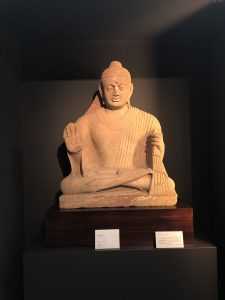
そんな仏像が日本に伝わりましたのは西暦538年。飛鳥時代に現在の朝鮮である百済より仏教が伝えられ、日本でも法隆寺などの寺院が造られ、そこで仏像の制作が始まりました。法隆寺金堂釈迦三尊像でもみてとれますように、ギリシャ彫刻的なリアルな表情はなくなっておりますが、アルカイックスマイルはうかがえますことは、かつて教科書で習った記憶が蘇ってまいりました。
そして、こちらは12世紀の日本の阿弥陀如来像ですが、フォルムはふくよかで、鼻の形も日本人にはどことなく親しみやすいかんじになっておりますし、あのガンダーラの仏陀像の表情とは顔の造りがちょっと違ってきたぞ…。ですが、そこにもほんのりと穏やかな笑みをたたえております。
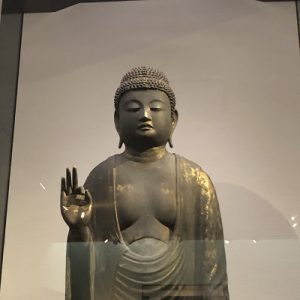
とまあ、私の稚拙な鑑賞にしばしお付き合いいただきましたが、仏像とさらに仏顔に特化した鑑賞は大変面白かったですし、ことにガンダーラ地方の仏像のイケメン像は眼福でありました。
それにしてもテーマが壮大過ぎまして私には手に負えそうもないですので、これらの学術的研究すでに多くの学者の先生が研究されておりますから、ご興味のございます方はもう少しアカデミックな文献など探って、是非、私に講義などしてほしいですね…。
それにしても、本当の仏陀に近いお姿の仏像はどれなのでしょうね。
それでは、ごきげんよう。
Hello everyone, this is Staff Y.
There are some areas that are very worried due to heavy rainfall caused by the recent linear precipitation zone. Please pay attention to the latest information and spend your time.
By the way, today is the sequel to the Ikuo Hirayama Silk Road Museum in Yatsugatake the other day.
In this museum, the masterpiece of Japanese painter Ikuo Hirayama, “Gandhara Tokizu” (1964), the Great Silk Road Series (2005), etc. are exhibited, and he has been greatly influenced and collected for about 40 years. The collection of antique art from the Silk Road has been exhibited one after another, but this term, the beautiful Buddha statues in the Gandhara region (northern Pakistan) where the Buddha statues were first made, and the Silk Road, from India to China. Buddha statues that were handed down to Southeast Asia, and Japan were exhibited.
When you look at the Buddha statues in each region, the first thing you notice is the genuine handsome Buddha faces of the Buddha statues in the Gandhara region. The hair is also richly wavy, the nose is squishy, and the archaic smile tends to be prone, and it is a Buddha statue that is more like a person.
You can see that it is influenced by Greek sculpture.
That should be it.
In the first place, it was forbidden to express the appearance of Buddha after the death of Buddha, but at the end of the 1st century, Buddha and Bodhisattva statues will be built in the Gandhara region around Peshawar in northwestern Pakistan.
Since the ancient Greeks established the Kingdom of Bactria in the middle of the 3rd century BC, ancient Greece (Helenism culture) has flourished here, and it is a culture of many ethnic groups such as Indians, Persians, and Greeks from the east and west. Perhaps because of the exchange, the Buddha statue is influenced by ancient Greek (Helenism culture) based on Indian culture.
Not only the face, but also the wavy hair is bundled, and when you see that many of them come in clothes with good physique and Greek drapes, how various styles are mixed in this region. It may be that it was, and I wonder if everyone was well integrated with it, and how to incorporate it is exquisite. Even so, fusion creates such a beautiful thing.
The Buddha’s face seems to have changed to various facial expressions through the Silk Road, but this Indian Buddha statue has a slightly plump face and body compared to the Gandhara region, and the meat Maybe because I liked it so much, my face is real.
The Buddha statue was introduced to Japan in 538 AD. Buddhism was introduced from the present Korean Baekje during the Asuka period, and temples such as Horyu-ji were built in Japan, where Buddhist statues began to be produced. As you can see in the statue of Shakyamuni Shakyamuni at Horyuji Temple, the realistic expression of Greek sculpture has disappeared, but you can see Archaic Smile in the textbook.
And this is a 12th century Japanese Amida Nyoraiji statue, but the form is somewhat plump, the shape of the nose is somewhat familiar to Japanese people, and the expression of that Gandara Buddha statue is a face. The structure is a little different … However, I also have a slight smile on it.
Various things are carried by the Silk Road, but even if the structure and appearance of the face has changed somehow, the smile continues forever.
Well, I was associated with my childish appreciation for a while, but it was very interesting to appreciate the Buddha statue and the Buddha face. I couldn’t convey it well, but many scholars have already studied these academic studies, so if you are interested, please explore a little more.
Even so, I’m wondering which Buddha image looks like a real Buddha.
*********************
このところ、整理やお片付けなどをされている方のご相談などが多くございます。お暑い日が続きますのでくれぐれもご無理のないように、なさってくださいませ。風光舎では、古美術品や骨董品の他にも絵画や宝石、趣味のお品など様々なジャンルのものを買受しております。
お片付けをされていて、こういうものでもいいのかしらと迷われているものでも、どうぞお気軽にご相談下さいませ。
また風光舎は、出張買取も強化しております。ご近所はもちろん、愛知県内、岐阜県、三重県その他の県へも出張いたします。
まずは、お電話お待ちしております。
愛知県名古屋市千種区・骨董 買取
『古美術 風光舎 名古屋店』
TEL052(734)8444
10:00-17:00 OPEN

